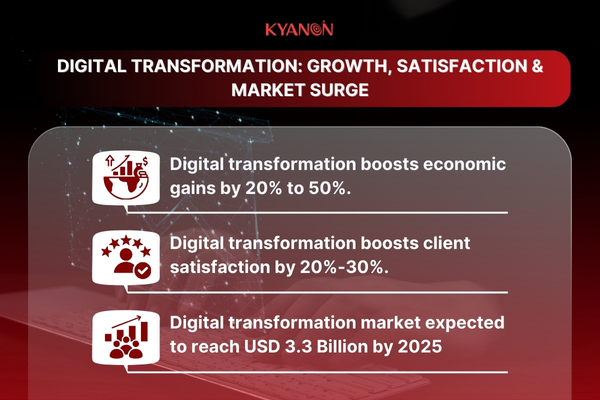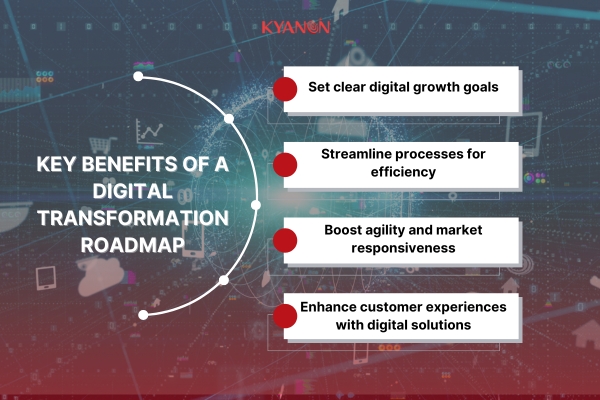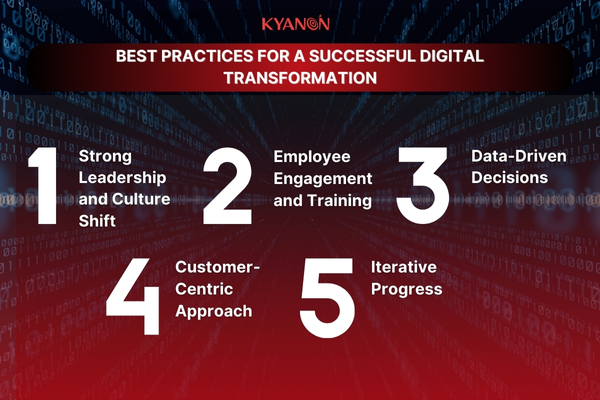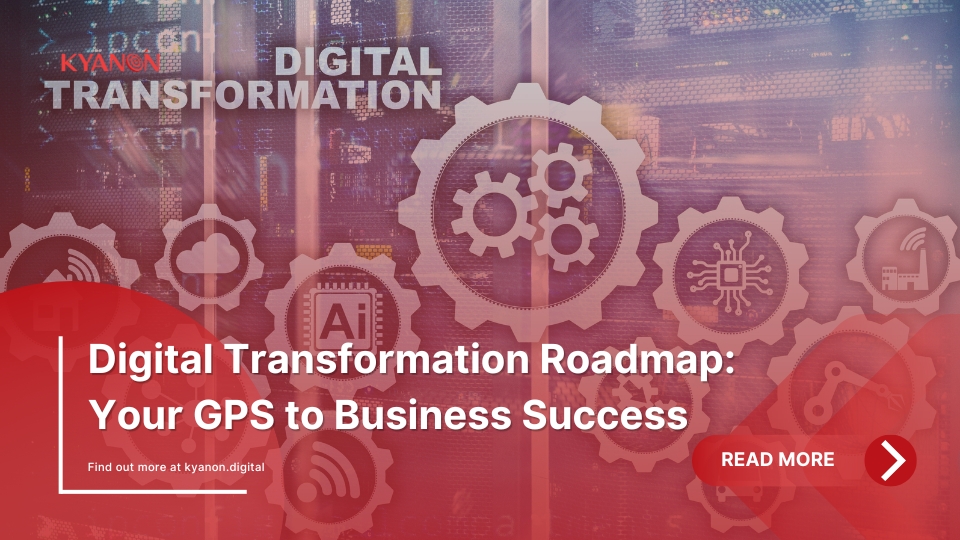A digital transformation roadmap is no longer a luxury; it’s a necessity for businesses aiming for long-term success. In today’s fast-paced digital world, companies embracing digital transformation are seeing impressive results like higher efficiency, improved customer experiences, and significant revenue growth. McKinsey reports that companies fully embracing digital transformation are 26% more profitable than those who don’t.

Think of a digital transformation roadmap as a business’s guide to navigating the digital era. It offers a step-by-step plan to evaluate existing systems, choose the right technologies, and implement them seamlessly—helping businesses streamline operations, boost performance, and stay ahead of the competition.
Understanding the phases of digital transformation is crucial for any business seeking to thrive in today’s tech-driven economy. It’s not just about upgrading tools; it’s about creating a culture of innovation, improving efficiency, and delivering more value to customers. The businesses that master this journey will lead their industries into the future.
In this blog, we’ll explore the key phases of digital transformation, share best practices, and show how a well-crafted roadmap can help businesses stay competitive and achieve sustainable growth. Let’s dive into how to turn digital challenges into opportunities for success!
1. What is a Digital Transformation Roadmap?
A digital transformation roadmap is a strategic plan that outlines the steps a business needs to take in order to transition to a more digital and technology-driven model. It serves as a clear guide, mapping out each stage of the transformation journey, from planning to execution. This roadmap helps businesses embrace new technologies, streamline operations, and improve customer experiences—all while remaining aligned with their core objectives and goals.
In simple terms, think of the digital transformation roadmap as a GPS to business success. Just like a GPS helps guide you to your destination while avoiding wrong turns, a well-defined roadmap offers businesses the direction they need to navigate through the complexities of digital change. Without it, companies risk veering off course and missing out on opportunities to enhance efficiency and innovation.

A study by Gartner revealed that 56% of companies with a formal digital transformation strategy are more likely to be successful in their efforts. With a clear roadmap, businesses can eliminate uncertainties, focus on achieving specific goals, and avoid common pitfalls during their transformation journey.
Incorporating a digital transformation roadmap isn’t just about implementing new tools or technologies; it’s about ensuring your organization evolves in a way that brings lasting value. It lays out the path for a seamless transition, reduces the risk of failure, and helps businesses stay ahead in a competitive digital landscape.
By following the roadmap, companies can:

- Set clear goals and objectives for digital growth
- Streamline processes and improve operational efficiency
- Increase agility and responsiveness to market changes
- Enhance customer experiences through digital solutions
Ultimately, the digital transformation roadmap is the key to turning digital challenges into real opportunities for growth and success.
2. Key Phases of the Digital Transformation Roadmap

2.1. Assessment & Vision
The first step in any digital transformation roadmap is to assess where your business stands and identify the challenges and opportunities. This involves evaluating your current processes, systems, and technologies to understand what’s working and what isn’t. It’s also about defining the goals you want to achieve through digital transformation—whether that’s improving customer experience, increasing operational efficiency, or driving innovation.
For example, a retail business may notice that its customer data is scattered across multiple systems, making it difficult to create personalized marketing campaigns. By assessing this challenge early, the company can then prioritize solutions like CRM systems that can integrate data and help deliver targeted marketing efforts.
This phase also includes aligning your digital strategy with your business goals. Whether you’re looking to increase sales, improve customer satisfaction, or streamline operations, your digital transformation efforts must tie directly into your long-term objectives.
2.2. Strategy Formulation
Once you understand your current position and have identified the goals, the next step is strategy formulation. This is where the magic happens. A successful digital strategy is tailored to your specific needs and industry.
For example, a company in the manufacturing sector may focus on automating production lines, while a financial services firm might invest in AI-driven analytics to improve customer insights. Your digital strategy should leverage industry insights and your unique business goals to build a roadmap that prioritizes initiatives that will bring the most value.
By aligning your strategy with your core business objectives, you ensure that every digital initiative is focused on delivering tangible, measurable results.
2.3. Technology Selection & Integration
With a strategy in place, it’s time to select the right technologies that will drive your transformation. This might include CRM systems, marketing automation tools, artificial intelligence (AI), cloud services, or data analytics platforms. Choosing the right tools depends on your specific needs, industry, and the goals you set in the strategy phase.
For example, an e-commerce business might integrate AI for personalized recommendations, while a healthcare provider may adopt advanced analytics to streamline patient care. The goal is to select technologies that align with your business objectives and ensure seamless integration with existing systems.
Technology selection should never be rushed. Make sure to thoroughly research options and select tools that are scalable and can evolve with your business over time.
2.4. Implementation & Optimization
Now that you have your strategy and technologies, it’s time to implement them. This phase involves taking actionable steps to roll out your digital transformation initiatives, such as training employees on new software, migrating data to cloud platforms, or rolling out automated marketing campaigns.
However, it doesn’t end there. After implementation, it’s essential to continuously monitor and optimize the new systems. Use data to track performance, identify bottlenecks, and refine processes.
For example, if a new CRM system is underperforming, analyzing user feedback and system data can help you adjust workflows or refine integrations to improve efficiency.
2.5. Scaling & Continuous Improvement
Digital transformation is not a one-time project; it’s an ongoing journey. After successfully implementing your strategy, the next step is scaling the transformation across different departments and functions.
For example, if your marketing team has successfully integrated a new automation tool, the next step is rolling it out to your sales or customer service departments.
Scaling also involves fostering a culture of innovation and continuous improvement. Encourage employees to adopt a mindset of ongoing learning and experimentation. By constantly looking for ways to innovate, businesses can stay ahead of competitors and continue to grow.
Ultimately, scaling and continuous improvement are what ensure that your digital transformation isn’t just a temporary fix but a sustainable, long-term strategy.
3. Best Practices for a Successful Digital Transformation
A successful digital transformation goes beyond simply adopting new technologies. It requires strategic steps and careful planning to ensure your business thrives. Here are some key best practices:

3.1. Strong Leadership and Culture Shift
Leaders play a crucial role in driving the transformation. They must set a clear vision, communicate the benefits, and guide the team through the change. Creating a culture that embraces innovation is also vital. Encouraging employees to adapt and support the shift is essential for a smooth transition.
3.2. Employee Engagement and Training
For a transformation to succeed, employees need to be on board and properly trained. Providing continuous training ensures teams are equipped to use new digital tools effectively. Involving them early in the process helps reduce resistance and fosters a sense of ownership in the change.
3.3. Data-Driven Decisions
Leveraging data is key to making informed decisions throughout the digital transformation journey. Using analytics to measure performance, optimize processes, and personalize customer experiences will help businesses achieve smarter and more effective results.
3.4. Customer-Centric Approach
Digital transformation should always keep the customer experience in focus. Whether it’s improving service delivery or streamlining processes, ensuring that technology enhances customer interactions will lead to better satisfaction and loyalty.
3.5. Iterative Progress
Rather than making large-scale changes all at once, implement the transformation in phases. Start small, assess the outcomes, and gradually expand. This allows for continuous improvement and reduces the risk of overwhelming the team or customers.
By following these best practices, businesses can ensure that their digital transformation roadmap is not only successful but also sustainable in the long run.
4. Common Mistakes to Avoid in Digital Transformation
Digital transformation is an exciting journey, but it can be easy to make missteps along the way. Avoiding common mistakes ensures that the transformation is successful, sustainable, and aligns with your business goals. Here are some pitfalls to watch out for:
4.1. Underestimating Change Management
One of the biggest mistakes businesses make is ignoring the importance of change management. Digital transformation isn’t just about new tools or technologies—it’s also about a shift in mindset and culture.
Without proper preparation, employees and leadership may struggle with the change. Taking time to communicate the vision, address concerns, and prepare teams for the cultural shifts is essential to creating a smooth transition.
4.2. Skipping the Planning Phase
Rushing into digital transformation without a solid plan is a recipe for failure. A clear roadmap is crucial to guide the transformation journey.
Before choosing new technologies or adopting new tools, businesses should first assess their needs, identify opportunities, and align digital strategies with their business goals. Skipping this planning phase can lead to poor technology choices and missed opportunities for optimization.
4.3. Neglecting Continuous Innovation
Many businesses treat digital transformation as a one-time event—once the new tools are in place, they consider the job done. However digital transformation is an ongoing process. Technologies evolve, customer needs change, and market conditions shift.
To stay competitive, businesses must continue innovating and refining their processes long after the initial transformation. This requires a commitment to continuous improvement and an agile mindset that embraces new growth opportunities.
By avoiding these common mistakes, businesses can stay on track with their digital transformation roadmap and ensure long-term success in the digital age.
5. From Zero to Hero: Real-Life Business Success Stories
Businesses that embrace a digital transformation roadmap can overcome challenges and emerge stronger, more efficient, and more competitive. Here are a few examples of companies that initially struggled but used a structured roadmap to achieve success:
5.1. Company A: Turning a Struggling Retailer Into an E-Commerce Giant
A well-known retail company was facing declining sales and increasing competition from online stores. They decided to embrace a digital transformation roadmap, starting with a deep analysis of their current systems and identifying key areas for improvement. By adopting e-commerce solutions, CRM tools, and optimizing their customer experience, they successfully shifted to an online-first model. Their sales grew by 35% within the first year, proving that with the right technology and strategy, transformation leads to remarkable results.
5.2. Company B: Revitalizing a Traditional Manufacturing Business
A manufacturing business was struggling with outdated systems, poor communication, and inefficient processes. They developed a digital transformation roadmap, focusing on automation, data analytics, and integrating advanced technologies like AI to optimize production lines. With continuous improvements and employee engagement, they reduced production time by 40% and increased their output without compromising quality. The company went from lagging behind competitors to becoming a leader in its industry.
Next Steps: How to Get Started?
In today’s fast-paced digital world, a well-crafted digital transformation roadmap is essential for businesses aiming to thrive and stay competitive. From assessing your current systems to selecting the right technologies and fostering a culture of innovation, each phase plays a critical role in shaping the future of your organization. By following a clear, structured roadmap, businesses can enhance operational efficiency, improve customer experiences, and unlock new growth opportunities.
Don’t let the digital age pass you by—start your transformation journey today. Kyanon Digital’s services include everything from cloud-based solutions to custom software development and AI integrations, ensuring your business not only adapts but thrives in the digital age.
Take action now—Contact Kyanon for your free consultation and start building your digital transformation roadmap today!

